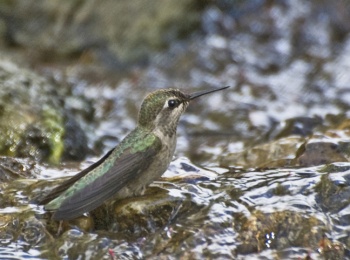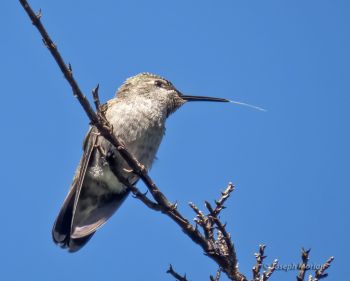- Calypte anna
Identification
10–11 cm (4-4½ in)
- Short straight black bill
- Glossy golden-green back
- Grey below
- Green flanks
- Long, straight and slender bill
Male:
- Glossy red crown and throat
- Dark tail
Female and juvenile:
- Green crown
- Grey throat with some red marking
- Dark tail with white tips.
Distribution
Southwest Canada (British Columbia) south through western USA (east to southern Arizona) to northwest Mexico (northwest Baja California). In winter occurs irregularly south to northern Sonora, southeast to Gulf Coast of USA, and even north to southeast Alaska; sporadically occurs much farther east.
Taxonomy
This is a monotypic species[1].
Habitat
Chapparal oak woods, the base of canyons and riparian woodland.
Behaviour
Breeding
The female builds a large, round, cup nest in a shrub or tree from very small twigs, lichen and other mosses, and often lined with downy feathers, soft plant material or animal hair. It is bound together with spider silk. The eggs are generally laid between November - May.
Diet
The diet includes nectar of native and introduced flowers, shrubs and trees and also insects.
Vocalisations
Song is a learned mixture of high-pitched scratchy buzzes followed by more melodious whistles and scratchy notes. Typical call is a short, sharp, dry tzip note. A loud pop is made acoustically by the male at the bottom of a territorial dive display.
References
- Clements, J. F., T. S. Schulenberg, M. J. Iliff, S. M. Billerman, T. A. Fredericks, B. L. Sullivan, and C. L. Wood. 2019. The eBird/Clements Checklist of Birds of the World: v2019. Downloaded from http://www.birds.cornell.edu/clementschecklist/download/
- Lepage D. (2020) Anna%27s_Hummingbird in Avibase - The World Bird Database. Retrieved 12April 2020
- Clark, C. J. and S. M. Russell (2020). Anna's Hummingbird (Calypte anna), version 1.0. In Birds of the World (A. F. Poole, Editor). Cornell Lab of Ornithology, Ithaca, NY, USA. https://doi.org/10.2173/bow.annhum.01
- Howell, S.N.G. 2002. Hummingbirds of North America. Academic Press
- Schuchmann, K.L. & Boesman, P. (2018). Anna's Hummingbird (Calypte anna). In: del Hoyo, J., Elliott, A., Sargatal, J., Christie, D.A. & de Juana, E. (eds.). Handbook of the Birds of the World Alive. Lynx Edicions, Barcelona. (retrieved from https://www.hbw.com/node/55656 on 20 October 2018).
- Wikipedia contributors. (2018, October 9). Anna's hummingbird. In Wikipedia, The Free Encyclopedia. Retrieved 08:45, October 20, 2018, from https://en.wikipedia.org/w/index.php?title=Anna%27s_hummingbird&oldid=863197293
Recommended Citation
- BirdForum Opus contributors. (2025) Anna's Hummingbird. In: BirdForum, the forum for wild birds and birding. Retrieved 5 February 2025 from https://www.birdforum.net/opus/Anna%27s_Hummingbird
External Links
GSearch checked for 2020 platform.








